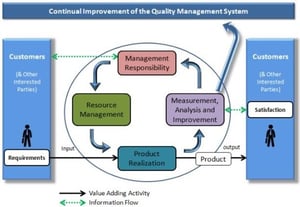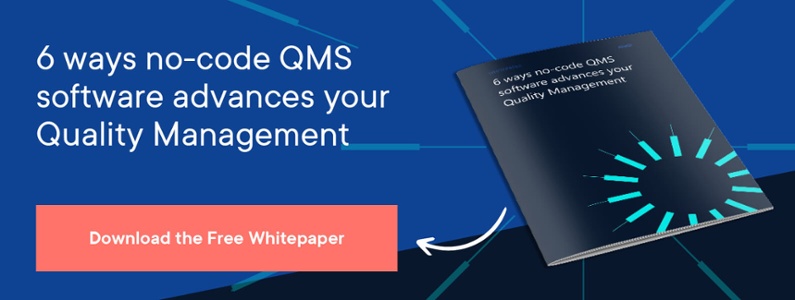There’s a popular saying in quality management that it didn’t happen if it’s not written. That’s why businesses that adhere to a quality management system need systematized and well-planned Quality Management Software.
However, many companies have failed to do so over the years, which has led to the loss of millions of dollars.
A $1.5 billion antenna problem
Take the release of the iPhone 4, for example. Apple nearly lost its place in the phone industry when the company unveiled the iPhone 4 in 2010. That’s because the phone had issues with network reception. Calls dropped suddenly when you touched a specific spot on the phone, causing an interruption in the cell signal. According to an estimation by Toni Sacconaghi, a research analyst, a full recall of the iPhone 4 could have cost Apple $1.5 billion.
Perhaps Apple could have prevented this loss with the right Quality Management Software, and so can your business. QMS is a vital part of your business because it helps you gain a competitive advantage. But it is only as effective as your commitment and persistence to accountability and adherence.
In this post, you’ll learn how to effectively implement a Quality Management System for your business. But first, why does QMS matter, especially in 2021?
Does QMS matter in 2021?
Do you remember the time you bought something you were really disappointed with? Maybe it was a smartphone, food, or something less costly like a coffee mug. How did you feel? Most people would get angry, go back to the shop or call customer care, and have a ‘few discussions with them’. Maybe you would too.
The main purpose of a QMS is to make sure such things don’t happen with your products and services. The ISO 9001:2015 is an international Quality Management Standard that helps your business to:
- Show the capability to offer products and services that your customer needs continuously
- Adhere to the applicable statutory and regulatory requirements
In the end, the main goal is to make sure that your customers are satisfied. The International Organization for Standardization (ISO) provides a full breakdown of QMS on its official website.
If so, then what is a QMS?
In simplest terms, a Quality Management System accumulates various business functions and processes to provide consistent quality improvement. The aim is to ensure that businesses meet their customers’ expectations and requirements.
With the use of Quality Management Software, it’s easy to provide quality products and services.
Effective ways to implement a Quality Management System
1. Visualize and define your processes
Creating a process map can help your business to visualize and define its processes. During the process, you can determine the interaction sequence, which can help you find and appreciate the responsible employee.
Determine your fundamental business process, and talk about the flow with your team. You can use the image below from Flowhelp.com as a guide.
 Image Source: flowhelp.com
Image Source: flowhelp.com
2. Outline your quality policy
The quality policy is a brief statement built on your company’s values and strategic direction. It provides a framework for quality work and ensures a commitment to follow applicable requirements strictly.
You can also refer to the quality policy as the mission statement, vision, or statement of principles. The quality policy is essential because it helps your employees to understand how their work affects product quality, including quality control. And that can determine the success or failure of your company.
3. Establish Your quality objectives
Quality objectives are measurable targets or goals that improve your customer satisfaction and aligns with the quality policy. These objectives are usually set when developing your QMS.
4. Track and Monitor Your CSF Data
When you establish your success criteria, you need to measure and monitor progress. To do this effectively you need Quality Management Software such as SPC software made for manufacturers.
Another example is LIMS software that can help you manage data effectively. The collected data can help you make an informed decision and enhance customer satisfaction. The image provided by cqeacademy.com gives a clear view.
 Image Source: cqeacademy.com
Image Source: cqeacademy.com
5. Correct any defects for every process
A defect is a type of non-conformity that happens when a product fails to meet the standard requirement. When a defect occurs, you need to measure and correct it as soon as possible.
That’s why when correcting the defects, you need to:
- Find out the operation volume
- Identify a way to record defects
- Specify the defects in the process and product
- Define a process through which you can report various defects in particular formats
6. Use Quality Management Software
Every time you use Quality Management Software, it means you’re delivering the best quality product for your customers. Through the process, you can:
- Gather data about defects and record it
- Review the collected data and take preventive measures
- Carry out internal audits and management reviews
- Review Failure Mode & Effects Analysis (FMEAs) for various risk and actions
7. Measure, track, and implement activities to boost performance
Using Quality Management Software (such as SPC or LIMS software for manufacturing) means retrieving data. That means you can analyze and make improvements and adjustments where necessary.
8. Train Your Employees
You need to adequately train your employees so that they can effectively produce quality products. They need to know your company’s strategy and objectives to understand where the company is headed.
Conclusion
Ensure that your employees grasp the full understanding of your company’s vision, especially the role they play in the maintenance of this vision. Find ways to make sure that you standardize all the company’s internal processes, from the tiniest details to complex operations. That way, you can be confident in the success of your business.
Finally, use the best Quality Management Software to produce the best quality products.
No-code Quality Management
While technological change is accelerating, the capacity to absorb this change becomes a bottleneck for many manufacturers. No-code Quality Management Software helps to eliminate this bottleneck.
Learn how no-code quality management can benefit your business.



